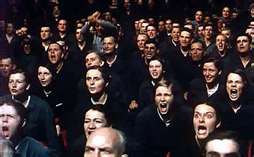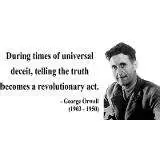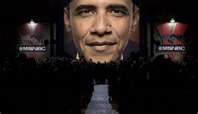 The opening chapter of Orwell’s dystopian nightmare Nineteen Eighty-four centers around the “Two Minutes Hate.” Winston Smith, the novel’s protagonist, describes pulling up a chair in front of the big telescreen, taking a seat among his Ministry of Truth co-workers, and participating in a ritual designed to reinforce party orthodoxy, Oceania’s version of Must-See-TV.
The opening chapter of Orwell’s dystopian nightmare Nineteen Eighty-four centers around the “Two Minutes Hate.” Winston Smith, the novel’s protagonist, describes pulling up a chair in front of the big telescreen, taking a seat among his Ministry of Truth co-workers, and participating in a ritual designed to reinforce party orthodoxy, Oceania’s version of Must-See-TV.
What follows is a wild display of enmity, precisely channeled and orchestrated by Ingsoc, the totalitarian rulers of Oceania. The chorus of hissing, squeaking, and screaming is focused on Goldstein, the ultimate enemy of the state, “the self-satisfied sheeplike face” that automatically “produced anger and fear” in everybody. Why? Goldstein stands for everything Ingsoc reviles. He demands peace and advocates “freedom of speech, freedom of press, freedom of assembly, freedom of thought.”
The Hate celebrates Ingsoc’s slogans—WAR IS PEACE, FREEDOM IS SLAVERY, and IGNORANCE IS STRENGTH—and helps stamp out thoughtcrime, i.e. the right to hold personal, unorthodox beliefs and value privacy, the very thing Winston secretly lives for. He’s actually a big fan of Goldstein. But even this devout intellectual heretic feels powerless to the overwhelming wave of emotion that ripples though the crowd and makes otherwise reserved and terse people start “leaping up and down…and shouting at the tops of their voices.” Take a look at a cinematic interpretation of this.
 The most horrific thing, Winston says, isn’t simply that he feels obliged to go along with it. It’s that even a true thoughtcriminal like himself finds it “impossible to avoid joining” the “hideous ecstasy of fear and vindictiveness, a desire to kill, to torture, to smash faces in with a sledgehammer.” Winston helplessly watches as his secret loathing for Big Brother, the face of the Party, becomes, for a brief, but terrifying moment, true adoration. This foreshadows the fate of his desperate revolt. In the end, Winston’s rebellion fails. He is destined to love Big Brother. The Two Minutes Hate gives us a disturbing glimpse into the psychological, and indeed physiological, means by which totalitarian control is possible. Orwell takes the reader right to the intersection of nature and nurture, where political propaganda sets its scalpel and goes to work, ‘healing’ us through the power of ‘proper’ beliefs—the pseudo-salvation of mind and body that comes from loving and hating the ‘right’ faces. Being an accepted member of your tribe, Orwell argues, is invariably linked to being fervently hostile towards the other tribe.
The most horrific thing, Winston says, isn’t simply that he feels obliged to go along with it. It’s that even a true thoughtcriminal like himself finds it “impossible to avoid joining” the “hideous ecstasy of fear and vindictiveness, a desire to kill, to torture, to smash faces in with a sledgehammer.” Winston helplessly watches as his secret loathing for Big Brother, the face of the Party, becomes, for a brief, but terrifying moment, true adoration. This foreshadows the fate of his desperate revolt. In the end, Winston’s rebellion fails. He is destined to love Big Brother. The Two Minutes Hate gives us a disturbing glimpse into the psychological, and indeed physiological, means by which totalitarian control is possible. Orwell takes the reader right to the intersection of nature and nurture, where political propaganda sets its scalpel and goes to work, ‘healing’ us through the power of ‘proper’ beliefs—the pseudo-salvation of mind and body that comes from loving and hating the ‘right’ faces. Being an accepted member of your tribe, Orwell argues, is invariably linked to being fervently hostile towards the other tribe.
In this way, Orwell’s diagnosis of totalitarian tactics prefigures a recent breakthrough in social psychology called Terror Management Theory (TMT). The idea is rooted in anthropologist Ernest Becker’s seminal work The Denial Death, which proposed that all human behavior is instinctively shaped and influenced by the fear of death. Whether we realize it or not, our ‘mortality anxiety’—a quality that appears to be unique to our species—is such a potent and potentially debilitating force, we have to repress and distract ourselves from it. But as Freud says, the repressed always returns, slipping into our conscious minds and affecting our behavior in lots of weird ways. This anxiety, according to Becker, feeds back into our psyche and influences everything we think and do. Our social practices and institutions—from politics to religion to art—are systematic attempts to explain away and allay this fear, which is why we can lash out so viciously at those who seem to threaten or undermine our beliefs. We can’t let their existence weaken our psychological armor against the ultimate enemy, Death itself.
Researchers Sheldon Solomon and Jeff Greenberg decided to put Becker’s hypothesis to the test by devising clever psychological experiments to isolate and measure the anxiety factor. Time and time again, they found that when people were made to think about their own death, they reacted in a more hostile way to those who were perceived as an ideological other than they did when they were not asked to contemplate it. You can check out these weird but illuminating experiments here.
 Terror Management Theory (TMT) can explain everything from the bloody sacrificial rites carried out by the Aztecs to the sudden and unquestioning support Pres. Bush received from many liberals after 9/11, people who on September 10th didn’t even think he’d legitimately won the office. The theory helps us grasp not only the irrational, cult-like power of charismatic leaders and the effectiveness of negative political ads, it presupposes a neurological basis for our susceptibility to the Love/Hate style of propaganda—how it taps into the way we’re wired and re-routes the circuitry so we become unwitting puppets to elitist agendas that don’t actually serve our interests. We become mouthpieces and pumping fists for the very forces that oppress us. In other words, you are not in control of your own beliefs and behavior, Big Brother has already gotten to your amygdala—the brain’s subcortical fear factory—and told you what to love and what to hate, the faces worth admiring and the faces that need to be smashed with a sledgehammer…or with a prejudicial slur or with a cruise missile.
Terror Management Theory (TMT) can explain everything from the bloody sacrificial rites carried out by the Aztecs to the sudden and unquestioning support Pres. Bush received from many liberals after 9/11, people who on September 10th didn’t even think he’d legitimately won the office. The theory helps us grasp not only the irrational, cult-like power of charismatic leaders and the effectiveness of negative political ads, it presupposes a neurological basis for our susceptibility to the Love/Hate style of propaganda—how it taps into the way we’re wired and re-routes the circuitry so we become unwitting puppets to elitist agendas that don’t actually serve our interests. We become mouthpieces and pumping fists for the very forces that oppress us. In other words, you are not in control of your own beliefs and behavior, Big Brother has already gotten to your amygdala—the brain’s subcortical fear factory—and told you what to love and what to hate, the faces worth admiring and the faces that need to be smashed with a sledgehammer…or with a prejudicial slur or with a cruise missile.
Orwell may not have grasped the neurology (he predates the f-MRI technology that allows us to see the amygdala in action), but he certainly understood the psycho-dynamics of TMT, fifty years before it was empirically verified by Solomon and Greenberg. The hate, Winston explains, flows through the group “like an electric current, turning one even against one’s will into a grimacing, screaming lunatic.” And yet, since its a primitive instinct which has been manipulated by social conditioning, this hate is “an abstract undirected emotion which could be switched from one object to another,” like a flashlight. In other words, we love and/or hate by nature, but the particular objects of our adoration and enmity are learned. The question is, have you learned how to consciously control this dynamic? Or has Big Brother already beat you to the punch?
Tragically, Winston can’t choose who to love and who to hate, and this, Orwell implies, is the ultimate agenda of an effective totalitarian state, one of its defining properties and ultimately its most fundamental power. Nineteen Eighty-four‘s dystopian vision—unrelentingly bleak and terrifying—still resonates because the kind of manipulation it describes hasn’t gone away with fall of the Soviet Union. Its machinations have just grown more subtle and are all the more powerful and hideous for it.
Orwell’s novel reminds us to step back from the histrionic media frenzies that pass for political discourse these days, take a rational breath, and ask ourselves: am I really in control of what I believe? Or am I motivated by fears I’m not even aware of? When I step into the booth and cast my ballot, am I making a conscious choice or has Big Brother already pushed the button for me?
Remember, Hitler initially gained power through the democratic process, which he then systematically dismantled. Do we really want to be free and rules ourselves or is there, as Freud argued in Group Psychology and the Analysis of the Ego (1922) something deep within in that longs to be subjugated and dominated? Do you secretly like it when Big Brother mashes his political finger against your limbic button?
Take a minute or two and think about it.






